- "Okay, make nice, give us the ray gun."
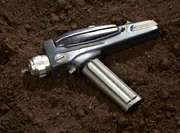
Type-2 hand phaser, 2260s
Starship phasers, 2280s
Phasers are the most common and standard energy weapon in the arsenal of Starfleet and several other powers. Most phasers are classified as particle weapons and fire nadion particle beams, (VOY: "Time and Again") but some like the Ferengi hand-phaser are classified as plasma weapons and fire forced plasma beams. (TNG: "Descent") Based on the intensity and field of the beam, a wide variety of effects can be achieved.
History
Phaser technology used by Starfleet was preceded by phase-modulated particle weapons in the mid-22nd century, including such weapons as the hand-held phase pistol and ship-mounted phase cannon. Laser weapons, such as the laser pistol were also used before phasers became the standard-issue weapon in the Starfleet arsenal. (Star Trek: Enterprise, all; TOS: "The Cage")
Phaser weaponry was invented during the 23rd century. (TNG: "A Matter of Time") The technology was used by Starfleet as early as 2233; the USS Kelvin was equipped with ship-mounted phaser weapons. (Star Trek) Phaser rifles were used as early as 2265, although at that time officers were still armed with laser pistols. (TOS: "Where No Man Has Gone Before")
Template:ShipClass starship firing from a phaser array and a Template:ShipClass starship firing with phaser cannons
The 24th century saw many new advanced forms of phaser weaponry, such as the ever more powerful phaser arrays that made use of multiple phaser emitter segments, and the powerful rapid-fire phaser cannon. (Star Trek: The Next Generation, all; DS9: "The Search, Part I") As a historical note, the regenerative phaser was chosen instead of the TR-116 for development. (DS9: "Field of Fire")
By the 29th century, phaser pistols were still used by Starfleet, (VOY: "Relativity") but subatomic disruptors were used on timeships, such as the Aeon, as the ship-mounted directed energy weapon. (VOY: "Future's End")
Descriptions and uses
The phaser beam can stun, heat, kill or disintegrate living creatures. Phasers can damage shields or other systems or even cut through a hull. Phasers can also be used to cut through walls and burrow through rock. The beam can be focused to a single spot or widened to impact a large area.
In the nadion particle beam phasers, plasma is passed to a phaser emitter resulting in a discharge of nadion particles. Residual particles can be found in places where a battle has recently taken place. The disruptive effects of nadion discharges are moderated to produce varying effects (discussed below), ranging from benign to extremely destructive. (VOY: "Phage", "Memorial", "Endgame")
Phaser rifle, 2370s
The Starfleet-issue personal phasers come in three types: The phaser type-1 (hand phaser) is small and can be concealed easily. The type 2 phaser is larger and hand-held. It has a longer hand grip or a pistol grip, depending on the model. The phaser type-3 is also known as the phaser rifle. It has a longer barrel, a stock, and some models have a second grip. This weapon can fire beams or bolts. Over centuries of use, there have been several models of the lightweight and effective phaser rifle. (TOS: "The Devil in the Dark"; TNG: "The Mind's Eye")
Beyond these, phasers are usually mounted devices, such as the phaser type-4 used on Starfleet shuttlecraft and other small vehicles, all the way up to the large phaser banks and phaser arrays of starships and space stations. Various classes of banks, arrays and emitters exist, such as the more powerful phaser type-8 and the phaser cannon. (TNG: "The Outcast", "Preemptive Strike"; VOY: "Live Fast and Prosper")
Hand phasers can be made to overload, either deliberately or by sabotage. Phasers in the process of overloading emit a distinctive high-pitched whine. The weapon will release all of its energy in an explosion capable of doing considerable damage to its surroundings. In 2266, Lenore Karidian attempted to murder James T. Kirk by hiding an overloading phaser in his cabin. (TOS: "The Conscience of the King") In 2269, Kirk, McCoy, and Sulu were almost killed while on the Kalandan outpost planet, when its defensive computer fused the controls on Kirk's phaser, causing it to overload. (TOS: "That Which Survives")
Personal phasers are also used by Starfleet personnel as tools and not just weapons. The phaser can be used to heat rocks and stones for warmth. (TOS: "The Enemy Within") While there were specialized tools like phaser bores and phaser drills, (TAS: "Once Upon a Planet"; VOY: "Once Upon a Time") Worf once used his type 2 hand phaser to open a tunnel on the Cardassian planet Celtris III. (TNG: "Chain of Command, Part I")
Different models of phaser make different sounds when fired, depending on the model and setting. Federation phaser fire typically makes a high-pitched "whistling" or "tearing" sound, for example. A knowledgeable person can use the sound to differentiate between types and power settings. (TOS: "Errand of Mercy"; TNG: "Too Short a Season"; DS9: "Sacrifice of Angels")
In 2369, two type-2 hand phasers at maximum level were unable to penetrate the toranium inlays of Cardassian doors. Major Kira Nerys recommended a bipolar torch to be used to cut through the door. (DS9: "The Forsaken")
In the alternate reality created by Nero's incursion, hand phasers of the late 2250s emitted bolts of phaser energy rather than the steady streams generated by phasers of the prime reality. In addition, these phasers had a rotating nozzle which flips when set from stun to kill or vice versa. (Star Trek)
Sidearm settings
The 23rd and 24th century phaser includes several settings.
- Setting number one is also called the base cycle stunning force. (TOS: "The Enemy Within") This minimal setting causes only a stun effect to the average humanoid lifeform. A hit will leave the target dazed and unable to think straight for a moment. (TOS: "The Man Trap") When used at close range, a phaser set on stun is still capable of inducing sufficient trauma to kill if fired at a vital organ such as the brain. (Star Trek VI: The Undiscovered Country) Two phasers set on setting one fired simultaneously can break large objects into pieces, such as the urns of Taurus II. (TAS: "The Lorelei Signal")
- Setting 3.1 is enough to cause a changeling to experience similar discomfort. Setting 3.4 or 3.5 was determined to be a stun setting that would effectively stun and force any changeling to revert back into the gelatenous state. (DS9: "Homefront") A wide-field stun setting is used when large groups need to be stunned with a single shot. (TOS: "The Return of the Archons") Some stun settings can also cause unconsciousness. Although mostly harmless when used at these low settings, multiple phaser stuns like this can result in injury and death. (TNG: "Samaritan Snare") There is a heavy stun force setting and a maximum stun setting also known as full stun charge. (TOS: "Tomorrow is Yesterday"; TNG: "Legacy"; TAS: "The Eye of the Beholder")
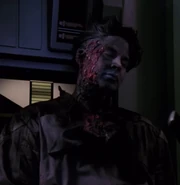
Damage caused by setting 6 or 7
- A phaser can be used to heat a variety of substances, such as rocks or even coffee (TOS: "The Enemy Within", "The Corbomite Maneuver ", " Spock's Brain") Phasers can be used to melt certain ores from solid to liquid. (TNG: "The Enemy") They can be used to quickly boil through tens of meters of ice. (TAS: "The Slaver Weapon") Phaser can be set to inflict non-lethal second degree burns. (VOY: "Worst Case Scenario") Settings 6 and 7 cause severe burns in the flesh of humanoids. (TNG: "Night Terrors") Setting 7 is also powerful enough to vaporize noranium carbide. (TNG: "The Vengeance Factor")
- One-quarter and level 10 are names of the kill setting for humanoid forms. (TOS: "The Man Trap"; TNG: "Aquiel") The kill setting on hand-phasers used by the Mordanites has a distinct sound from the stun setting. (TNG: "Too Short a Season") To a humanoid infected by a neural parasite, the kill setting only causes unconsciousness, due to the high levels of adrenaline in the target's body. However, extended exposure to a body part such as the head of a humanoid would cause it to explosively vaporize. Two phasers set to kill can also disintegrate smaller lifeforms such as the neural parasite mother creature with extended exposure. (TNG: "Conspiracy")
- Cutting settings can be used to slice off segments of a steelplast wall, (TNG: "Too Short a Season") a standard starfleet corridor wall (TOS: "The Naked Time") or even to slice off body parts. (Star Trek VI: The Undiscovered Country)
- The normal maximum setting on a hand phaser will vaporize a humanoid lifeform or a human size android with a single hit. (TOS: "What Are Little Girls Made Of?";TNG: "The Vengeance Factor"; Star Trek: First Contact) This is also called disintegration. (ENT: "In a Mirror, Darkly, Part II") When used as a means of suicide, the phaser will also disintegrate along with the person shooting at himself. (TOS: "Elaan of Troyius") There is also a maximum setting that can set parts of clothing or humanoids on fire. (TNG: "Datalore", "The Wounded") Against a Horta, even when set specifically for silicon, the maximum setting will only hurt it. (TOS: "The Devil in the Dark") Disruptor-B is another maximum setting for the type 2 phaser. It is also called the disruptor effect setting. This setting was assessed to be the most effective against gaseous dikironium. (TOS: "Obsession")
- The standard level 16 setting on a type 2 phaser can be used to vaporize tunnels through rock, large enough to crawl through. (TNG: "Chain of Command, Part I") The level 16 wide-field setting can easily destroy half of a large building with a single shot. (TNG: "Frame of Mind") However there were materials phasers couldn't cut through even at this maximum level, such as toranium, (DS9: "The Forsaken") and the unknown material used to create the Hotel Royale on Theta VIII. (TNG: "The Royale")
Types of phaser weapons
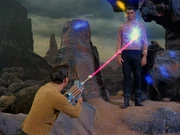
Kirk firing a type 3 phaser
The diagram of the ship-mounted phaser bank on Constitution-class starships

The alternate Enterprise firing all phasers
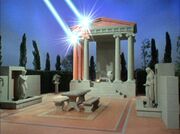
Enterprise phaser banks disintegrating a building
There are several numbered types of phasers of increasing size and capability: Types 1, 2, and 3 are personnel phasers, and types 4 and above are ship-mounted weapons. The phasers mounted aboard starships are considerably more powerful than those used by Starfleet personnel, owing to the increased power reserves available. Early phasers, such as the MK IX/01 type found on the USS Enterprise, were mounted in banks of one or two emitters, firing in either proximity blasts or beams. The ship's phasers also have a stun setting, and can be set for a wide-beam. (TOS: "Balance of Terror", "The Trouble with Tribbles", "A Piece of the Action")
It was possible to configure phaser emitters to fire laser pulse beams, photon pulses and pulse compression waves. (TNG: "Peak Performance", "The Outcast"; DS9: "Emissary")
In the alternate reality created by Nero's incursion, phasers aboard the USS Enterprise were used to fire bolts resembling proximity blasts. (Star Trek)
Hand-held phasers
- Type 1 phaser is a small concealable sidearm weapon.
- Type 2 phaser is a larger sidearm-type weapon which evolved from a pistol-style design.
- Type 3 phaser is a rifle-sized weapon.
These main types and technologies are further classified to distinguish the many variations.
- hand phaser
- plasma phaser - a proposed anti-Borg weapon
- regenerative phaser
Starship-mounted phasers
- particle phaser - used on transport ships from Boreal III
- phaser bank
- phaser array
- phaser cannon - used on Template:ShipClass starships
- phaser type-4 - used on type 6 shuttlecrafts
- phaser type-8 - used on Template:ShipClass starships
- Galor-class phaser bank
Appendices
See also
References
- TOS:
- Star Trek V: The Final Frontier
- Star Trek VI: The Undiscovered Country
- TNG:
- "Encounter at Farpoint"
- "Samaritan Snare"
- "The Outcast"
- "Chain of Command, Part II"
- DS9:
- ENT:
Background information
According to The Making of Star Trek, phasers are basically lasers, but they have the beam set on a pulsating frequency that can be specifically set to interfere and interact with the wave pattern of any molecular form. This is called "phasing" the beam frequency, hence the name.
According to the Spaceflight Chronology, phaser weapons were developed by Starfleet to combine the benefits of two previously used weapon technologies, particle-beam cannons and laser banks. While particle weapons delivered a big punch, they had trouble penetrating shields, where as lasers penetrated shielding easily, but had very little impact force to do damage. Two years after the events of "The Cage", when the problem with frequency aligning the two systems to work simultaneously in ship-mounted phasers was solved, the development of hand phasers began. (page 173)
Star Trek: The Next Generation Technical Manual explains the inner mechanisms of a phaser. Phaser is the acronym for phased energy rectification according to the process of turning stored energy into an energy beam without intermediate transformation. Energetic plasma is pumped to a prefire chamber made out of a superconducting lithium-copper. There it undergoes a rapid nadion effect in which strong nuclear forces are liberated. A protonic charge forms and is released in pulses to the emitter made out of the same superconductive crystal. A beam of elecromagnetic energy is released from it at the speed of light. (pages 123-125)
On starships, energy for phasers originates from the EPS, while on hand units the charge of energetic plasma is stored into sarium-krellide. This material is used because it can't accidentally release the charge of plasma.
According to the Star Trek: Deep Space Nine Technical Manual, the EM energy beam of a phaser can be delivered at warp speeds due to an annular confinement beam jacket and other advances in subspace technology. These are stated to be new inventions in the late 24th century. (page 84)
When phasers are fired by a ship with deflector shields active, the beam is frequency locked to the second-order harmonics of the shield emissions. This prevents the beam impacting on the shields and overloading them, or rebounding back at the firing ship. (page 92)
The Template:ShipClass is the earliest ship design shown to employ phaser strips.
Phaser settings
The Star Trek: The Next Generation Technical Manual (pages 135 - 137) lists various settings for Type-1, Type-2 and Type-3 phasers, some of which have not been mentioned on screen and some which have been given a different effect.
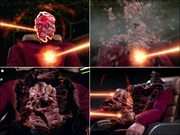
Skin vaporization and internal organ explosion
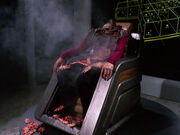
Remains of Commander Remmick
- Type 1 phasers have the first eight settings; Type-2 and -3 phasers have all sixteen settings:
- Light Stun - causes central nervous system impairment on humanoids, unconsciousness for up to 5 minutes. Long exposure by several shots causes reversible neural damage.
- Medium Stun - causes unconsciousness from 5 to 15 minutes. Long exposure causes irreversible neural damage, along with damage to epithelial tissue.
- Heavy Stun - causes unconsciousness from 15 to 60 minutes depending on the level of biological resistance. Significantly heats up metals.
- Thermal Effects - causes extensive neural damage to humanoids and skin burns limited to the outer layers. Causes metals to retain heat when applied for over five seconds.
- Thermal Effects - causes severe outer layer skin burns. Can penetrate simple personal force fields after five seconds of application.
- Disruption Effects - penetrates organic and structural materials. The thermal damage level decreases from this level onward.
- Disruption Effects - due to widespread disruption effects, kills humanoids.
- Disruption Effects - causes a cascade disruption that vaporizes humanoid organisms. Any unprotected material can be penetrated.
- Disruption Effects - causes medium alloys and structural materials, over a meter thick, to exhibit energy rebound prior to vaporization.
- Disruption Effects - causes heavy alloys and structural materials to absorb or rebound energy. There is a 0.55 second delay before the material vaporizes.
- Explosive/Disruption Effects - causes ultra-dense alloys and structural materials to absorb or rebound energy before vaporization. There is a 0.2 second delay before the material vaporizes. Approximately 10 cubic meters of rock are disintegrated per shot.
- Explosive/Disruption Effects - causes ultra-dense alloys and structural materials to absorb or rebound energy before vaporization. There is a 0.1 second delay before the material vaporizes. Approximately 50 cubic meters of rock are disintegrated per shot.
- Explosive/Disruption Effects - causes shielded matter to exhibit minor vibrational heating effects. Approximately 90 cubic meters of rock are disintegrated per shot.
- Explosive/Disruption Effects - causes shielded matter to exhibit medium vibrational heating effects. Approximately 160 cubic meters of rock are disintegrated per shot.
- Explosive/Disruption Effects - causes shielded matter to exhibit major vibrational heating effects. Approximately 370 cubic meters of rock are disintegrated per shot.
- Explosive/Disruption Effects - causes shielded matter to exhibit light mechanical fracturing damage. Approximately 650 cubic meters of rock are disintegrated per shot.
The Star Fleet Technical Manual gives the effective ranges for different settings. On the Type 1 phaser they are: stun - 30 meters, heat - 2 meters, disrupt - 20 meters, dematerialization - 10 meters. On the Type 2 phaser the ranges are: stun - 90 meters, heat - 6 meters, disrupt - 60 meters, dematerialization - 30 meters. Setting dials on the hand phasers indicate 9 settings on the Type 1 phaser and 15 on the Type 2 phaser, of which all above 10 are labeled by the letters A to E.
Effects

A Klingon warrior is hit by a phaser blast.
Phasers are often seen vaporizing or disintegrating matter. However, if vaporization were, in fact, occurring, a tremendous amount of heat would be liberated by the sudden conversion of a great deal of biomatter to vapor. For instance, if a person were instantly vaporized into carbon-dioxide, enough heat would be released to seriously injure or destroy objects within a radius of several meters. The nadion effect may result in matter-neutrino conversion, resulting in exotic particles. This is one possible explanation for the varied effects phasers seem to have on their targets (particularly the Klingon soldier who is thrown through the air by Kirk's phaser blast in Star Trek III).
The images included above in the description of the Type-1 power settings are most of the few times we clearly see the damage caused by higher settings less than those causing vaporization of the target. Most of the time the production team just used "squib" explosions at the point of impact, with no other damage to the target (probably for budgetary reasons).
Commenting on phaser firepower, Ronald D. Moore said: "The weapons are way too powerful to present them in any realistic kind of way. Given the real power of a hand phaser, we shouldn't be able to show ANY firefights on camera where the opponents are even in sight of each other, much less around the corner! It's annoying, but just one of those things that we tend to slide by in order to concentrate on telling a dramatic and interesting story." (AOL chat, 1997)
Other types of starship phasers
- Type V phaser is used on auxiliary craft. In Star Trek: The Next Generation Technical Manual it is stated that type 7 shuttlecrafts and type 9A cargo shuttles use phaser emitters of this type during special operations. According to Star Trek: Starship Spotter the Chaffee shuttlepod and the Delta Flyer also uses this phaser type.
- Type VI phaser is used on auxiliary craft and runabouts. According to the Star Trek: Starship Spotter the Aeroshuttle and Template:ShipClass starships phaser arrays are of this type.
- Type VII phaser is used on starships. According to the Star Trek: Deep Space Nine Technical Manual and Star Trek: Starship Spotter the twin phaser banks on Template:ShipClass starships are of this type.
- Type IX phaser is used on starships. According to the Star Trek: Deep Space Nine Technical Manual the Template:ShipClass, Template:ShipType, Template:ShipType, and one type of Excelsior-class variant uses them. The phaser emitters in the rotary weapon arrays of the weapon sail towers of Deep Space 9 are of this type.
- Type X phaser is used on starships. According to Star Trek: The Next Generation Technical Manual this is the type name of the phaser arrays used on the Template:ShipClass starships. According to the Star Trek: Deep Space Nine Technical Manual the Template:ShipClass, Template:ShipClass, Template:ShipClass, Template:ShipClass, Template:ShipClass and one type of Constitution-class variant also use them. The fixed phaser emitters in weapon sail towers of Deep Space 9 are of this type. According to Star Trek: Starship Spotter the Template:ShipClass and Template:ShipClass also use them.
- Type X+ phaser is used for planetary defense. According to Star Trek: The Next Generation Technical Manual this is the designation of some large dedicated planetary phaser defense emitters.
- Type XI phaser is used normally for planetary defense. According to the Star Trek: Deep Space Nine Technical Manual the emitters were designed to minimize atmospheric blooming of the beam. The phaser emitters in the carriages, embedded into the habitat ring of Deep Space 9, are of this type, modified for use in space.
- Type XII phaser is used on starships. According to Star Trek: Starship Spotter this is the type designation of the phaser cannons of the Template:ShipClass starships and the standard beam phaser arrays of the Template:ShipClass and Template:ShipClass starships.
None of these type designations have been mentioned on screen.
Template:PhaserTechnology
